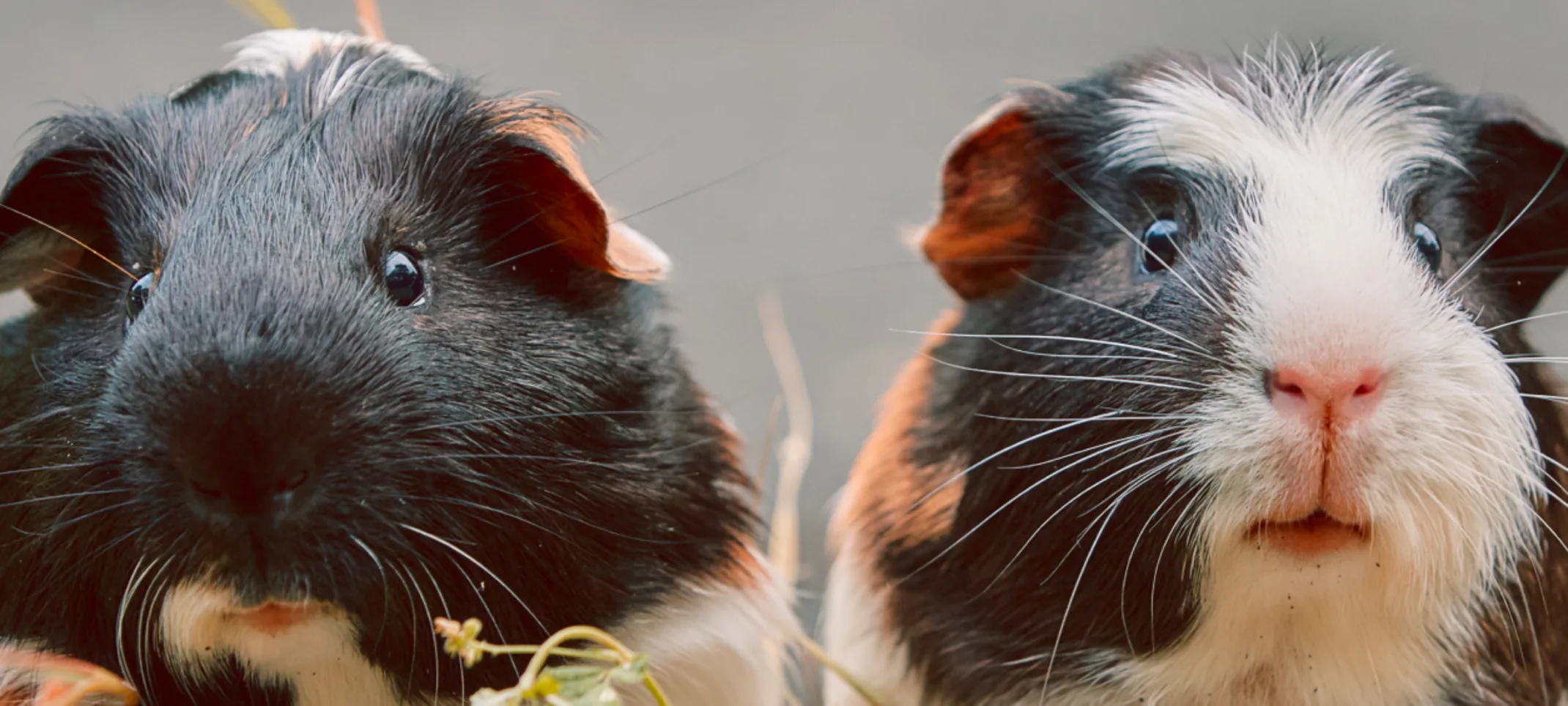I-20 Animal Medical Center
Guinea Pig Husbandry
Guinea pigs make great pets! They are friendly, engaging and are fun to be around.

Guinea pigs make great pets! They are friendly, engaging and are fun to be around. Guinea pigs are rodents, and are closely related to chinchillas. Guinea pigs come in several main coat types, the most common being the American/European short hair (the most common kind of cavy with smooth hair) and the Abyssinian (think lion with cowlicks!). Guinea pigs can also have silky, long hair (Silkies and Peruvians) and they can be hairless! Adult guinea pigs are usually about 1-2 lbs and can live 5-7 years.
Getting to Know Your Cavy
Mother Guinea Pig and her two babies against white background Guinea pigs are very vocal and will let you know how they are feeling. A happy pig will coo and purr when happy, and will make high pitched squealing noises when upset or scared. Guinea pigs also say hi by bumping noses! Guinea pigs are typically friendly and with gentle, slow handling will easily get used to being picked up by their people. To pick up your guinea pig, support him under the belly and hind limbs and cup him gently. Never pick up your guinea pig by the scruff, or flip him upside down.
Housing
Cages for guinea pigs should be made of stainless steel, plastic or glass, should be well ventilated, easy to clean, and offer ample space (18”x24” minimum per pig). The tops of the cages should be open, and the height should be at least 10-12” to prevent escape. Flooring should be solid and not made of wire mesh because cavies are prone to getting foot pad disease as well as toes getting caught and broken in the mesh squares.
Hide boxes or “pigloos” are essential to give your pig a sense of safety and a place of retreat. At least one hide box per guinea pig should be offered. Pick wooden or edible pigloos and avoid plastic ones as these can get chewed and ingested, which cause intestinal problems. Food bowls should be heavy to prevent tipping (ceramic are best) and water should be offered through bottles that hang on the cage. Fresh food and water should be offered daily, and bowls and bottles should be thoroughly cleaned daily to prevent bacterial buildup.
Substrate
Guinea pigs should be kept on a shredded paper, recycled newpaper, or similar product like Carefresh bedding. Corn cob, aspen, pine and cedar beddings as well as wood shavings or chips are NOT recommended due to the risk of dust and respiratory irritation. They also increase the risk of bacterial and fungal pneumonia, as these organisms can grow quite rapidly, even in bedding that is being changed frequently. Substrates should be changed and cleaned every few days to avoid ammonia buildup in the cage.
Nutrition
Guinea pigs are herbivores, and the majority of their diet should be high fiber hay. Timothy hay is best for adult guinea pigs, and should be offered free choice at all times. The hay is not only nutritious; it helps the guinea pigs keep their teeth ground down and prevents dental disease. Hay should be about 70-80% of a guinea pig’s diet. Commercial guinea pig pellets should also be offered daily (ideal brands are Oxbow, Mazuri and Kaytee). Fresh vegetables can be offered daily (see link to Vitamin C rich foods) as well as carrots as treats. Avoid broccoli and cabbage as these can cause gas and intestinal upset. Very small amounts of fruit (strawberry tops with leaves for example) can be offered rarely as treats, but too much fruit in the diet will cause intestinal disease.
Guinea pigs are special in that they need daily Vitamin C supplementation in their diet, or they develop scurvy (see below for details on scurvy). Though commercial water drops and chews are available for purchase, these are not usually recommended as they do not provide adequate Vitamin C. Vitamin C is also found in pellets, but is only viable for about 90 days once the food is made, so this is also not a reliable source of Vitamin C. The best way to give your guinea pig Vitamin C supplementation is by feeding appropriate fresh vegetables daily. See the link below for a PDF handout of recommended vegetables. Take note of the starred foods on this list; these are higher in oxalates, and should be fed only sparingly to avoid increasing the risk of developing bladder stones.
Note – avoid rapid changes in diet, as this can cause your guinea pig to stop eating and drinking, which can lead to gastrointestinal disease and stasis. Guinea pigs need to eat consistently to keep their intestinal bacteria happy, so when they don’t eat for over 12 hours, this is a problem as their normal, beneficial bacteria begin to die.
Medical Care
New pet guinea pigs should be examined within the first week to look for any signs of illness and intestinal parasites. Bring your guinea pig in a carrier or travel cage for safety. Exams should then be performed once a year to make sure your cavy is healthy. Preventative spaying and neutering is helpful to not only prevent certain diseases but also increase lifespan.
Knowing the common diseases in guinea pigs and what signs to look for will help you know if you need to bring your cavy in for an exam. With exotic pets, they tend to hide signs of illness until they can no longer possibly maintain the appearance of being normal. This is because they are prey animals, and their instincts tell them that to survive they must look happy and healthy or they will be targeted by predators. Unfortunately for us, this means that usually when we first notice our pet guinea pigs are sick, they have actually been sick for days if not weeks. You usually don’t have the luxury of a “wait and see” approach to see if your cavy is going to get better without treatment. Early medical care is vital to helping your guinea pig! Below are some common diseases in guinea pigs and what signs to watch for in your pets:
Dental disease/malocclusion
Seen in older guinea pigs and younger guinea pigs fed a diet low in hay, dental disease can be a frustrating disease to treat. Because guinea pigs have continuously growing teeth, if the teeth are not ground down by chewing on food and other objects like wooden toys, the teeth can overgrow. Sharp points on the teeth can cause oral pain, infections, and even grow to entrap the tongue if left untreated long enough. Signs of dental disease include slobbering or excessive drooling, decreased appetite, preference for soft foods, pawing at or rubbing at the mouth, and intestinal upset. Treatment includes addressing the current teeth overgrowth and adjusting husbandry to prevent it in the future. Treatment is usually needed for life once malocclusion happens.
Vitamin C deficiency (scurvy)
Guinea pigs with a diet deficient in Vitamin C will develop scurvy. Signs include dental disease (with loose teeth and gingivitis that causes bleeding gums), decreased appetite, painful joints, decreased mobility due to pain, and even bowing of the long bones with fractures possible.
Dystocia (difficulty giving birth)
Female guinea pigs must have their first litter of pups prior to 7 months of age, or their pelvis bones will fuse and prevent a normal birth. Dystocia is common and treatment involves a C-section and spaying of the guinea pig at the same time if possible.
Respiratory disease/pneumonia
Guinea pigs are prone to respiratory issues, especially those housed on natural beddings and not on Carefresh. Signs include discharge or crusting around the eyes and nose, increased respiratory rate, clicks or crackles heard when breathing, and a decreased appetite. Early intervention is important so upper respiratory infections do not turn into pneumonia.
Lice
Newly acquired guinea pigs, especially those housed with a lot of other guinea pigs, can come with lice. Lice can be seen moving through the coat, and diagnosis is fairly simple because these guinea pigs are itchy! Be aware that not all over-the-counter medications designed for dogs and cats to get rid of lice are safe for guinea pigs. CONSULT WITH YOUR VETERINARIAN prior to administering anything to your guinea pig, as some medications can be deadly.
Ringworm
Just like dogs and cats (and people!), guinea pigs can get ringworm. This is a skin fungus that causes hair loss, crusting, and itching. Don’t let the name fool you – there isn’t always a circular appearance to the hair loss.
Ovarian cancer
Older female guinea pigs that aren’t spayed are at risk of developing ovarian cysts and cancer. Signs can range from decreased appetite to bloody discharge in the urine or from the vulva. Surgical removal is ideal.
Enteritis
Guinea pigs on poor diets, those with sudden diet changes, and those with underlying illnesses or stress can be prone to intestinal disease. Signs include loose fecal pellets or diarrhea, decreased frequency of fecal pellets, decreased appetite, lethargy, and with worsening dehydration, sunken eyeballs and wrinkly skin. Because guinea pigs need to eat often to keep their beneficial intestinal bacteria healthy, intestinal inflammation causing appetite loss can be deadly if not treated early. If your guinea pig has gone 12 or more hours without eating, this indicates a problem that needs veterinary attention.
A minimum of a 30 day quarantine period is recommended for any new pet being brought into a home with existing exotic pets. This is to protect the owner’s previous pets from any new diseases or parasites a new pet could be carrying. Most infectious diseases will have symptoms show up within that 30 day period. Quarantined pets should be kept in a separate room if possible, and have separate food and water bowls throughout the quarantine period. Handle your previous pets first, then handle your new pet last. After the quarantine period is over, and your new pet has shown no signs of illness and has seen a veterinarian, your previous pets should be safe from most communicable diseases.
